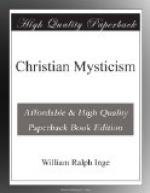It has been said that “Mysticism is the philosophy of Spain.[284]” This does not mean that idealistic philosophy flourished in the Peninsula, for the Spanish race has never shown any taste for metaphysics. The Mysticism of Spain is psychological; its point of departure is not the notion of Being or of Unity, but the human soul seeking reconcilation with God. We need not be on our guard against pantheism in reading the Spanish mystics; they show no tendency to obliterate the dividing lines of personality, or to deify sinful humanity. The cause of this peculiarity is to be sought partly in the strong individualism of the Spanish character, and partly in external circumstances.[285] Free thought in Spain was so sternly repressed, that those tendencies of mystical religion which are antagonistic to Catholic discipline were never allowed to display themselves. The Spanish mystics remained orthodox Romanists, subservient to their “directors” and “superiors,” and indefatigable in making recruits for the cloister. Even so, they did not escape the attention of the Inquisition; and though two among them, St. Teresa and St. Juan of the Cross, were awarded the badge of sanctity, the fate of Molinos showed how Rome had come to dread even the most submissive mystics.
The early part of the sixteenth century was a period of high culture in Spain. The universities of Salamanca and Alcala were famous throughout Europe; the former is said (doubtless with great exaggeration) to have contained at one time fourteen thousand students. But the Inquisition, which had been founded to suppress Jews and Mahometans, was roused to a more baneful activity by the appearance of Protestantism in Spain. Before the end of the sixteenth century, the Spanish people, who up to that time had been second to none in love of liberty and many-sided energy, had been changed into sombre fanatics, sunk in ignorance and superstition, and retaining hardly a trace of their former buoyancy and healthy independence.[286] The first Index Expurgatorius was published in 1546; the burning of Protestants began in 1559. Till then, Eckhart, Tauler, Suso, and Ruysbroek had circulated freely in Spain. But the Inquisition condemned them all, except Ruysbroek. The same rigour was extended to the Arabian philosophers, and so their speculations influenced Spanish theology much less than might have been expected from the long sojourn of the Moors in the Peninsula. Averroism was known in Spain chiefly through the medium of the Fons Vitae of Ibn Gebirol (Avicebron). Dionysius and the scholastic mystics of the Middle Ages were, of course, allowed to be read. But besides these, the works of Plato and Plotinus were accessible in Latin translations, and were highly valued by some of the Spanish mystics. This statement may surprise those who have identified Spanish Mysticism with Teresa and Juan of the Cross, and who know how little Platonism is to be found in their theology. But these two militant champions of the counter-Reformation numbered among their contemporaries mystics of a different type, whose writings, little known in this country, entitle them to an honourable place in the roll of Christian Platonists.




